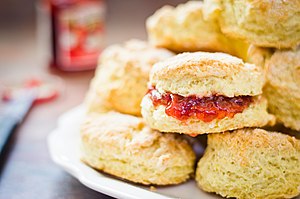Cookbook:Scone
| Scone | |
|---|---|
 |
Cookbook | Recipes | Ingredients | Equipment | Techniques | Cookbook Disambiguation Pages | Baking
The scone is a baked good of Scottish origin. They are very similar to North American biscuits (many recipes are actually identical), and savory scones in the United States may also be referred to as "biscuits".
Characteristics
editScones are small quickbreads made of wheat, barley, or oatmeal, usually with baking powder as a leavening agent. They may be sweet or savory, and they can take the shape of wedges, rounds, triangles, rectangles, or diamonds.
British scones are often lightly sweetened but may also be savoury. American scones are often baked to a more crumbly texture and can be somewhat like a cross between a cookie and a muffin, depending on the variety. In Canada, scones tend to be called "biscuits" or "tea biscuits".
In both Britain and the USA, mass-produced scones tend to be doughier than home-made scones.
Varieties
editBritish scones frequently include raisins, currants, cheese, or dates.
In Scotland and Northern Ireland, savoury varieties of scone include soda scones, also known as soda farls. Potato scones, normally known as tattie scones, resemble small, thin savoury pancakes made with potato flour and like the Jewish latke. They are most commonly served fried in full a Scottish breakfast or an Ulster fry.
In the United States, sweet scones often include fillings such as cranberries, blueberries, nuts, poppy seeds, or chocolate chips. Savoury varieties of scone often contain various combinations of cheese, onion, bacon, ham, scallions or chives, etc.
A griddle scone is a variety of scone that is fried rather than baked. Other common terms include dropped scone or drop scone, after the method of dropping the batter onto the griddle or frying pan to cook it.
Preparation
editScones are prepared according to the "biscuit method",[1] where the fat is cut or rubbed into the dry ingredients before adding the wet ingredients to form the dough. The dough is then shaped, and scones are cut out, placed on a baking sheet, and baked in a hot oven. Alternatively, the dough can be baked and then cut into pieces. As mentioned above, drop scones and griddle scones are instead fried on a griddle.
Serving
editThe scone is a basic component of the cream tea or Devonshire tea. They are also frequently eaten at breakfast and/or brunch.
Recipes
editGallery
edit-
Scone with jam and cream
-
Scones served with jam and clotted cream (commonly known as a cream tea)
-
Swedish cheese scones
-
Cutting out scones
-
Apple oatmeal scones
-
Buttermilk scones
-
Lemon scones
-
Cheese and chive scones
-
Scone with cream and jam
External links
editReferences
edit- ↑ Brown, Alton (2004). I'm Just Here for More Food. New York: Stewart, Tabori & Chang. pp. 146–147. ISBN 978-1-58479-341-0.